

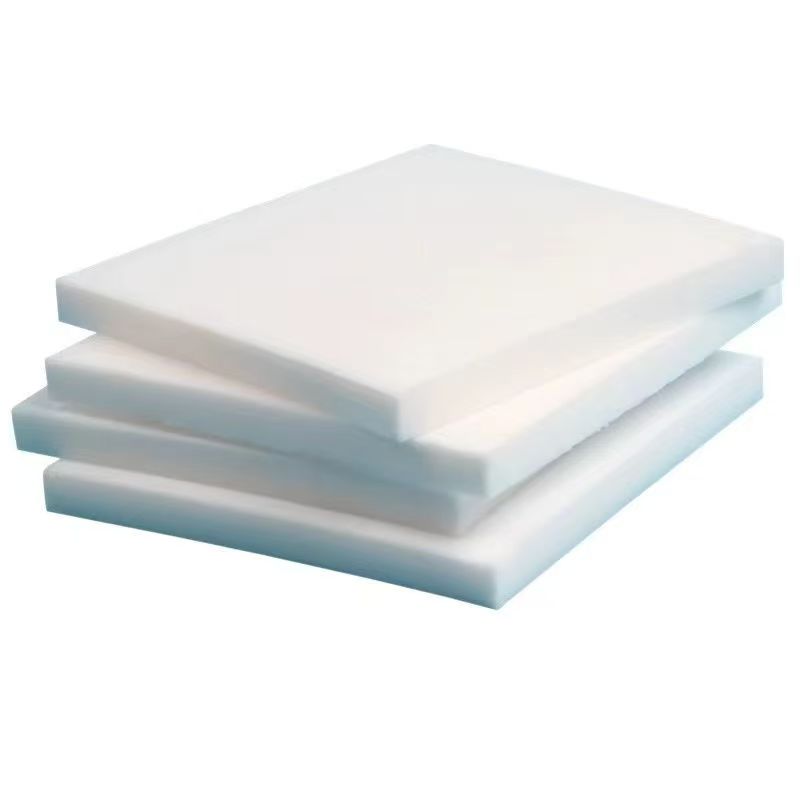
04 2025
Abstract: Using polytetrafluoroethylene (PTFE) as the reinforcing phase and adding different contents of glass fiber (GF), PEEK/PTFE composites were prepared by injection molding. Tensile tests were carried out using a mechanical testing machine, surface friction tests were carried out using a friction testing machine, and the wear scar data and three-dimensional morphology were observed using a white light instrument. The wear scars were observed and analyzed using a scanning electron microscope. The results show that when the GF content is higher, the maximum stress of the composite is higher and the slope of stress increase is more obvious. When the GF content increases to 30%, the maximum stress of the composite is increased to 183 MPa. As the GF content gradually increases, the friction coefficient of the composite surface decreases. When the GF content is 30%, the friction coefficient of the composite is reduced to 0.08. When the GF content is 0, 15%, and 30%, the wear rates of the composites are 3.59×10-6, 2.30×10-6, and 1.78×10-6 mm3(/N‧m), respectively. The higher the GF content, the higher the hardness of the composite and the better the wear resistance.
Keywords: Polytetrafluoroethylene sheet; glass fiber; polytetrafluoroethylene gasket; Teflon sheet; Teflon gasket
Polyetheretherketone (PEEK) is a material with excellent mechanical properties, high thermal stability, high corrosion resistance, and good wear resistance. It is widely used in high-end equipment, aerospace, automobile manufacturing and other fields [1-4]. However, due to poor thermal conductivity and high friction coefficient of pure PEEK, there is also a relatively high wear rate in dry friction conditions, which to some extent limits the application of PEEK in different industries [5-6]. In order to make PEEK adapt to more application scenarios, Molazemhosseini et al. [7] and Yao Guangdu et al. [8] studies have shown that fillers with lubricating effect are added to PEEK particles to improve the wear resistance of PEEK. Although adding polytetrafluoroethylene (PTFE) to PEEK can improve wear resistance, it also sacrifices the strength and high-temperature friction performance of PEEK to a certain extent, limiting its application in heavy loads and other harsh environments. Liu Ying [9] added 10%-15% carbon fiber (CF) to the PTFE/PEEK composite board by plain weaving. The results show that the sample with CF has better friction performance than the sample without CF. Gu Guohua et al. [10] prepared polyetheretherketone/carbon fiber/epoxy resin (PEEK/CF/EP) composite board by means of impregnation coating and molding process. The results show that the composite board has high fracture toughness and impact strength. Huang Suling et al. [11] prepared multi-walled carbon nanotube (MWCNT) reinforced PEEK composites by sintering process. The results show that MWCNT can reduce the friction coefficient and wear rate of the composite. In addition to adding fillers with lubricating effect, domestic scholars also study adding particles that improve the strength of PEEK alone to PEEK. Li Enzhong et al. [12] conducted dry sliding wear experiments on short-cut glass fiber reinforced polyetheretherketone (PEEK/GF) composites with a mass fraction of 30% under room temperature and high-speed conditions, and investigated the influence of load and frequency on the friction coefficient and wear amount of the material. The results show that as the load and frequency increase, the friction coefficient and wear amount of PEEK/GF gradually increase and tend to be stable. Zhao Ting [13] studies have shown that the mechanical properties of PEEK composites increase with the increase of GF content.。
Adding particles with lubricating effect alone in PEEK will reduce the overall strength of PEEK. Adding particles that increase the overall strength of PEEK alone will reduce the friction coefficient of PEEK. These schemes have certain limitations. Studying the addition of particles with lubricating effect and particles that increase the strength of PEEK simultaneously in PEEK is of great significance, especially for improving the mechanical and friction properties of PEEK. From the perspective of improving the comprehensive performance of PEEK, in this experiment, PEEK samples reinforced with PTFE with different GF contents were prepared by injection molding process, and tensile tests and friction performance tests were carried out on the samples. The influence of different GF contents on the mechanical properties and comprehensive friction properties of PEEK/PTFE composites was studied, and the action mechanism of GF content on the strengthening and toughening mechanism of PEEK/PTFE composites was analyzed to provide support for improving the comprehensive performance of PEEK.
1. Experimental part
1.1 Main raw materials
Polytetrafluoroethylene (PTFE) particles, JF-4TN, particle size 30 μm, Zhejiang Juhua Co., Ltd.; Polyetheretherketone (PEEK) particles, 085G, particle size 20 μm, Changchun Jida Special Plastics Engineering Co., Ltd.; Glass fiber (GF), Z/QCD3, fiber diameter 7.5 μm, fiber length 3 mm, Hebei Duofuyi Technology Co., Ltd.
1.2 仪器与设备
Universal tensile testing machine, Exceed E45, MTS Corporation, USA; Injection molding machine, VI-55DRES, Zhongtai Precision Machinery (Guangzhou) Co., Ltd.; Multifunctional friction and wear testing machine, MFT-5000, white light profilometer, MFP-D, Rtec Corporation, USA; Scanning electron microscope (SEM), EVO108, Hebei Duofuyi Technology Co., Ltd.
1.3 Sample preparation
According to GB/T 1040.2—2006, make injection molds and injection molded strips according to the specified dimensions. PTFE and PEEK particles are mixed in a mass ratio of 1:6, and then GF with a mass fraction of 0, 15%, and 30% is added respectively, and put into a mixer to stir evenly. After the mixing is completed, it is put into an injection machine to make injection molded strips, and friction test blocks with a size of 4 cm×4 cm×2 cm are made. Table 1 shows the formulations of different PEEK/PTFE composite materials.
1.4 Performance Testing and Characterization
Tensile property test: Conduct the test according to GB/T 1040.2—2022. The tensile speed is 1 mm/min. The test process continues until the sample strip is completely broken, and then the test data recording is stopped. Friction property test: The friction test adopts a linear reciprocating motion form and is carried out under unlubricated dry friction conditions. The mating part for friction is a Si3N3 ceramic ball. The load is 50 N, the frequency is 2 Hz, the sliding stroke of the grinding head is 5 mm, and the test time is 30 minutes.
The calculation formula for wear rate (W) is:
W = VF × S = ALF × S
In Equation (1): V is the volume of the wear mark on the spline, in mm3; S is the sliding stroke of the grinding head, in mm; F is the load in the experiment, in N; A is the cross-sectional area of the wear mark, characterized by a topography instrument, in mm2; L is the total length of the wear mark. In this test, it is a reciprocating friction test, which is twice the length of the wear mark, in mm. Morphological analysis: After the friction test is completed, a white light profilometer is used to observe the friction marks and three-dimensional morphology on the surface of the test spline. SEM is used to observe the wear mark.
2 Results and Discussion
2.1 Mechanical properties of composite materialsFigure 1 shows the stress-strain curves of PEEK/PTFE composite splines under different GF contents.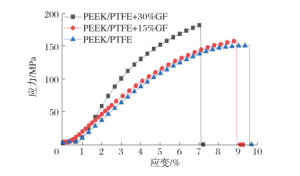
Fig.1 Stress-strain curves of PEEK/PTFE composites withdifferent GF content
As can be seen from Figure 1, when the GF content is 0, the maximum stress of the composite spline is the smallest among all components, which is 151 MPa. When the GF content is 30%, the maximum stress is the largest among all components, which is 183 MPa. The spline with a GF content of 30% has the most obvious increase in slope. The stress of the spline with a GF content of 0 has the least obvious change trend with strain. Because GF acts as a reinforcing phase in the PEEK/PTFE matrix and plays a skeletal role, it can resist the external force. The higher the GF content, the higher the tensile strength of the composite spline. At the same time, the addition of GF also increases the brittleness and reduces the toughness of the composite. Therefore, the higher the GF content of the composite spline, the more obvious the increase in stress slope. Although the higher the GF content, the higher the tensile strength of the composite spline, when the GF content is too high, the injection pressure during production increases, the production difficulty and cost increase sharply, and the surface of the composite material will appear floating fibers, and the deformation of the material surface will also increase accordingly. Therefore, the GF content in this experiment is controlled within 30%.
2.2 Friction coefficient of composite materials
Figure 2 shows the friction coefficient curves of PEEK/PTFE composites under different GF contents. As can be seen from Figure 2, the higher the GF content, the lower the surface friction coefficient of the composite. When the GF content is 30%, the surface friction coefficient of the composite material is reduced to about 0.08. Because the addition of GF fully fills the voids between the molecular chains of PEEK and PTFE [15], the friction coefficient of the composite is reduced.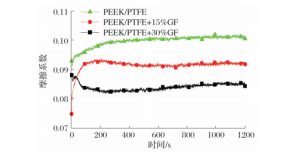
Fig.2 Friction coefficient of PEEK/PTFE composites withdifferent GF content
2.3 Wear resistance of composite materials
Figure 3 shows the wear scar cross-section curves and three-dimensional wear scar morphologies of PEEK/PTFE composites with different GF contents.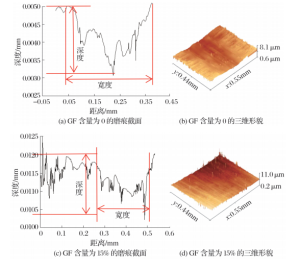
Fig.3 Cross section and 3D morphology of wear marks of PEEK/PTFE composites with different GF content
As can be seen from Figure 3, the width of the wear scar of the composite material with a GF content of 0 is 0.34 mm, and the depth of the wear scar is 0.0029 mm. The wear scar is wide and the depth is obvious. The width of the wear scar of the composite material with a GF content of 15% is 0.23 mm, and the depth of the wear scar is 0.0018 mm. The wear scar is narrow and the depth is not obvious. The width of the wear scar of the composite material with a GF content of 30% is 0.16 mm, and the depth of the wear scar is 0.002 mm. The wear scar is relatively narrow and the depth is not obvious.
Figure 4 shows the wear rate of PEEK/PTFE composites under different GF contents. As can be seen from Figure 4, the wear rate of the composite decreases with the increase of GF content. The wear rate of PEEK/PTFE + 30% GF composite is 1.78×10-6 mm3/(N‧m). Because GF prevents large-area destruction of the internal banded structure of PEEK/PTFE, it is beneficial to the generation of transfer film on the worn surface. In addition, the higher the GF content, the higher the hardness of the composite and the higher the wear resistance.
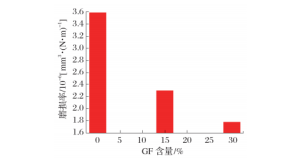
Fig.4 Wear rate of PEEK/PTFE composites withdifferent GF content
2.4 SEM analysis of composite materials
In order to study the influence of GF content on the wear mechanism of PEEK/PTFE composites, SEM was used to study the surface wear morphology of PEEK/PTFE composites with different GF contents. Figure 5 shows SEM photos. As can be seen from Figure 5, the surface wear mark width of PEEK/PTFE composites is relatively large, with obvious depth and accompanied by attachments. The material surface shows a certain degree of wear, with serious pits on the surface and accompanied by a certain degree of furrows. This indicates that the main mechanism of this wear is adhesive wear. The surface wear mark width of PEEK/PTFE + 15% GF composites is relatively small, with no obvious depth, but there are debris on the worn surface. There are a small number of pits on the material surface and a local transfer film is generated, indicating that the main wear mechanism is abrasive wear. The surface wear mark width of PEEK/PTFE + 30% GF composites is relatively small, with no obvious depth, and the surface wear mark is slight. There is no wear on the material surface and a transfer film is generated. The addition of a large amount of GF forms a uniform and continuous transfer film on the worn surface, so that the composite material achieves a lower friction coefficient and wear rate without obvious wear. When the GF content is 0, in the initial stage of composite material wear, on the one hand, PTFE forms a transfer film on the friction interface, thereby avoiding direct contact between parts that rub against each other. On the other hand, PTFE can reduce the friction coefficient of the part surface [16], which is beneficial to improving the wear resistance of the composite material. However, as the wear time and load increase, the formed transfer film is gradually destroyed and a certain amount of adhesion occurs. The composite material surface begins to wear, so adhesive wear occurs [17]. When 15% GF is added, the voids between the molecular chains between PEEK and PTFE in the composite material are fully filled, and the friction coefficient of the composite material is further reduced. During the friction process, the role of PTFE in forming a transfer film in the PEEK/PTFE composite is further strengthened, and the wear resistance of the composite material is improved. However, as the wear time and load increase, a certain amount of GF breaks, and PEEK wears to form a certain amount of particulate matter on the surface, so that the transfer film is gradually destroyed, and abrasive wear occurs on the composite material surface [18]. When 30% GF is added, the voids between the molecular chains between PEEK and PTFE are further filled, improving the compactness. Moreover, GF acts as a reinforcing phase in the PEEK/PTFE composite matrix and plays a skeletal role. The synergistic effect with PEEK in resisting external forces is strengthened, and the ability to withstand high loads is improved, so the wear resistance is better.

Fig.5 SEM images of wear mark of PEEK/PTFE composites withdifferent GF content
3. Conclusion
(1) The stress-strain change trends of PEEK/PTFE composites under different GF contents are different. When the GF content is higher, the maximum stress is higher, the slope of stress increase is more obvious, the stronger the ability of GF to resist the external force in the matrix, and the more obvious the strengthening effect on PEEK/PTFE composites.
(2) The friction coefficient of the surface of PEEK/PTFE composites is different under different GF contents. The higher the GF content, the more sufficient the filling of the voids between PEEK and PTFE molecular chains, and the lower the friction coefficient of the surface.。
(3) Under unlubricated dry friction conditions, the wear resistance of PEEK/PTFE composites with different GF contents is different. The higher the GF content, the stronger the protection ability of the internal banded structure of PTFE/PEEK, and the better the wear resistance of the composite.
(4) The addition of GF plays the role of a reinforcing phase in the PEEK/PTFE composite. A synergistic effect is formed among various components, which is beneficial to the improvement of the tribological and mechanical properties of the material and the enhancement of the ability to bear high loads. The research on the addition amount of GF in the composite can provide theoretical support for engineering practical applications.
This article was uploaded by Hebei Duofuyi Technology Co., Ltd. Please click on the product links: polytetrafluoroethylene (PTFE) sheet, Teflon sheet, polytetrafluoroethylene (PTFE) gasket, Teflon washer.
We focus on the research and development as well as manufacturing
of thermal insulation materials and sealing materials.